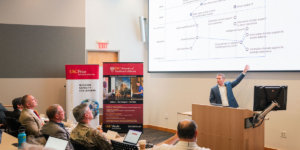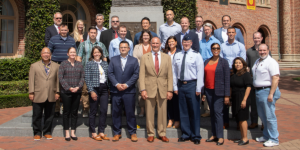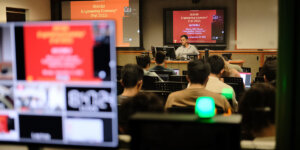
(Left to right) Joel Joseph, General David Petraeus, Kaushal Saraf and Varsha Varadarajan (Photo/Courtesy of Joel Joseph)
The Few, The Proud.
The United States Marine Corps, one of the nation’s four armed services branches, has protected Americans since 1775. Operating aboard ships, on land, and even in the air, the Marines have a reputation as among the nation’s fiercest and most elite fighting forces.
However, they have long faced an implacable enemy that continuously wreaks havoc: equipment breakdowns. A faulty engine in a combat ship could temporarily render the vessel unseaworthy, while a couple damaged gears in a Humvee could take the vehicle out of commission. The Marines spend nearly $7 billion annually on maintenance, according to U.S. government statistics.
At present, the Marines have few good options for quickly and inexpensively finding replacement parts for hobbled ships, military vehicles, and planes. Defense contractors sometimes charge exorbitant prices for rare spare parts, which could take months or even years to produce. Alternately, the Marines could make design files and 3-D print parts themselves. However, rigorous parts’ testing takes time and resources, leaving ships, vehicles and planes in maintenance.
The three USC Viterbi students who comprise the fledgling startup Atomus believe they have come up with an idea that would benefit both the Marines and defense contractors and, in the process, improve America’s security.
Atomus is developing technology that would allow defense contractors to license their 3-D design files to the Marines, making possible pay-per-print 3-D printing. The team, which recently won the H4D (Hacking for Defense) Starts and USC Marshall’s New Venture Seed competitions, has prototyped a USB device that plugs into any 3-D printer and counts the number of times a 3-D print file is printed.
“Atomus allows the military to get design files straight from defense contractors, who had not previously shared files with the military because they could not charge per print. The military will no longer have large parts of its fleet in maintenance for an extended amount of time waiting on parts. Furthermore, the Marines [and other branches] can take advantage of the cost savings of 3-D printing parts,” said team member Joel Joseph, an undergraduate computer science major.
“Defense contractors would essentially get paid royalties for simply allowing us to license their underutilized intellectual property,” he added.
Atomus and the Marines
Atomus team members collaborated over the summer with engineers in the Marine Corps’ San Jose Innovation Cell to improve its technology. The goal: modify Atomus devices so they could eventually be integrated with the Marine’s 3-D printers and comply with the service branch’s policies, regulations and systems, Joseph said. By the end of the summer the team had a working prototype currently integrated with the 3-D printers on the base. If all goes as planned, Marines at Camp Pendleton will soon test the company’s devices with their 3-D printers on a larger scale.
“It’s amazing the amount of organic growth we have gotten from the Marine Corps,” said Atomus co-founder Kaushal Saraf.
The U.S. Department of Defense sees so much potential in Atomus that it awarded the team a contract before the USC Viterbi students had even formed the company.
“I’m committed to team Atomus and their mission, because success for them would mean success for the Marines and DoD,” said Maj Bobby J. Bradford, a Marine and Atomus advisor. “I do believe someday the Marines will employ their technology.”
The Atomus Story
Joseph, Saraf, and Varsha Varadarajan, a master’s students in computer science, cofounded Atomus in the Hacking for Defense class in spring 2019. Over the course of the semester, the trio conducted over 140 customer discovery interviews with defense contractors as well as policymakers and members of the military, refining their concept along the way.
“With interviews from Pentagon leadership, the Marines and others, our team was able to validate that we had found a major pain point for the military,” Saraf said.
Atomus advisors included Clifford Neuman, director of the USC Center for Computer Systems Security at USC’s Information Sciences Institute (ISI) and USC Viterbi associate professor of computer science practice; and Farzin Samadani, a national I-Corps instructor from the National Sciences Foundation-backed Innovation Node-Los Angeles.
“Throughout the semester, the Atomus team applied the methodology taught in the course to discover the real needs of the customer and to propose a solution that was driven by the actual needs,” Neuman said. “ The team’s solution was driven by their problem discovery, in contrast with the all too common academic project methodology that might be described as a solution in search of a problem.”
Neuman and Samadani taught USC’s H4D course at USC in 2018 and 2019, discussing fundraising, business models, doing business with Department of Defense (DoD), solution architectures, and the importance of interviewing experts in the marketplace. Based on the I-Corps “Lean Startup” approach to entrepreneurship, the course teaches students to quickly pivot and change course based on new information.
The H4D course is taught at several universities across the country, including Stanford and Georgetown, but rarely has it been connected to a university’s own defense innovation initiatives.
At USC, H4D is part of Project PALISADES (Promote, Accelerate, and Launch Innovation in the Security, Aerospace, and DEfense Sectors), an initiative of the USC Viterbi Office of Technology Innovation and Entrepreneurship linking the Silicon Beach, military, and aerospace communities.
In sponsoring the class, DoD hopes to bridge the gap between the military and elite students. The Defense Department also wants such students to step back and reframe real-world problems through in-depth interviews and hands-on experimentation, after which they could suggest meaningful technological solutions that address military needs.
Atomus recently filed a provisional patent on its core technology that allows for pay-for-print on any 3-D printer, Joseph, the Atomus cofounder, said. The startup is also in the process of raising seed money. He hopes other branches of the military, as well as the private sector, will one day use Atomus technology, which would also include an online portal listing defense contractors’ 3-D design files available for licensing.
“We have a deep passion for this and the desire to build something great,” Joseph said.
Published on September 9th, 2019
Last updated on April 14th, 2021











